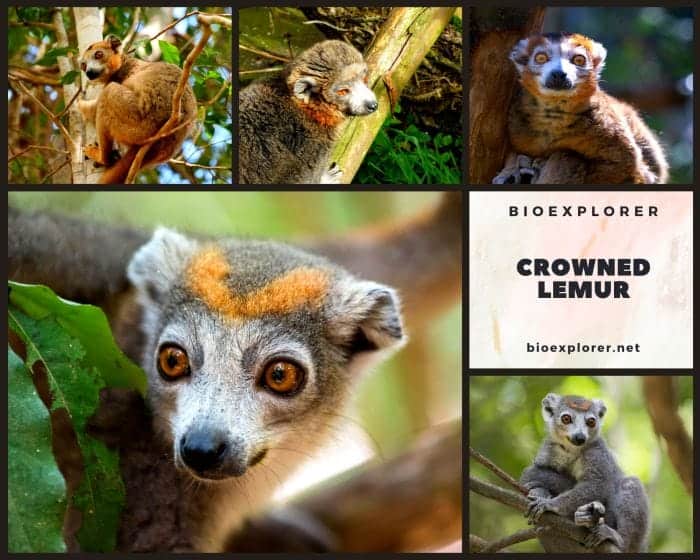
| Animalia | Mammalia | Primates | Lemuridae | Chordata | Eulemur coronatus |
The crowned lemur (Eulemur coronatus) is a stunning primate found only in the tropical forests of northern Madagascar. Identified by their distinctive v-shaped crown pattern and long, dense black and white fur, these Lemurs play an important role in seed dispersal and forest regeneration.
Despite being lesser known than the ring-tailed lemur, the endangered crowned lemur is vital to Madagascar’s incredible biodiversity. This comprehensive guide will explore the crowned lemur’s habitat, physical characteristics, diet, social behaviors, reproduction, threats they face, and more about this magnificent prosimian.
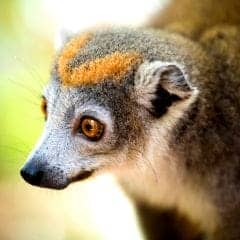

- Common Name: Crowned Lemur
- Taxonomy Classification Year: 1842
- Monkey Size: 31 to 36 cm (12 to 14 in)
- Skin Color(s): Light gray or reddish-brown
- Habitat: Forest, scrub forest
- Diet: Omnivorous
- Native Countries: Madagascar
Table of Contents
- Where Do Crowned Lemurs Live?
- Crowned Lemur Physical Characteristics
- Crowned Lemur Diet and Feeding Habits
- Crowned Lemur’s Digestive System
- Crowned Lemur Social Structure and Behaviors
- Crowned Lemur Scent-Marking and Communication
- Crowned Lemur Reproduction and Breeding
- Crowned Lemur’s Polyspecific Associations with Sanford’s Lemurs
- Crowned Lemur Conservation Status and Threats
- What Eats Crowned Lemurs?
- Crowned Lemur Captive Breeding
- Crowned Lemur Fun Facts
- Frequently Asked Questions
- What is the habitat of the eulemur coronatus?
- Can we see eulemur coronatus in a zoo?
- What is the mating behavior of Crowned Lemurs?
- Could you describe the distribution and habitat of Crowned Lemurs?
- What is their social behavior like?
- How does the crowned lemur look like?
- What does the Crowned Lemur mainly feed on?
- When are young Crowned Lemurs usually born?
- When are Crowned Lemurs most active?
- Are Crowned Lemurs endangered?
- Conclusion
Where Do Crowned Lemurs Live?
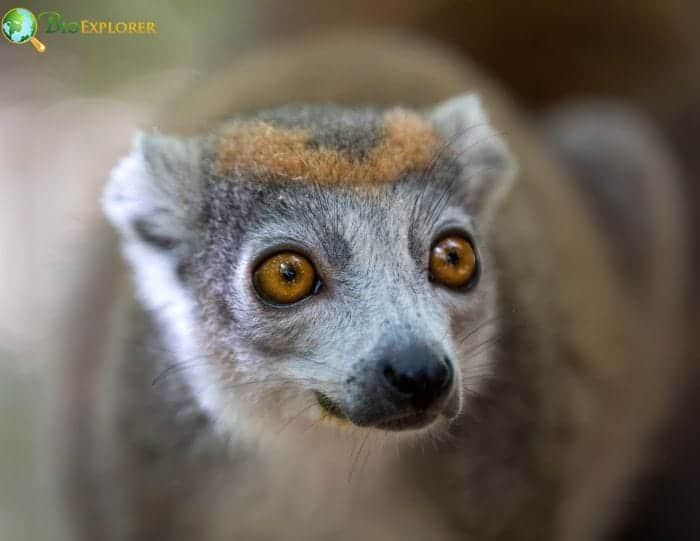
Crowned lemurs are only found in the tropical dry forests of extreme northern Madagascar. Their range is limited to a narrow strip along the SAVA region, which includes:
- Sambirano forests
- Andapa lowland forests
- Tsaratanana reserve
- Manongarivo reserve
Specifically, most crowned lemur troops occupy mid-altitude rainforests 3,280 to 4,920 ft above sea level in this region. However, they have been observed from sea level up to 4,600 ft elevations.
Unlike other lemurs, crowned lemurs traverse the razor-sharp limestone tsingy formations dominating parts of their habitat. At night, troops will sleep in the dense canyon forests for safety.
The crowned lemur shares its habitat with the similar Sanford’s brown lemur in these northern forests. Though they overlap significantly in home range and resource use, studies show niche separation between the species.
Crowned Lemur Physical Characteristics
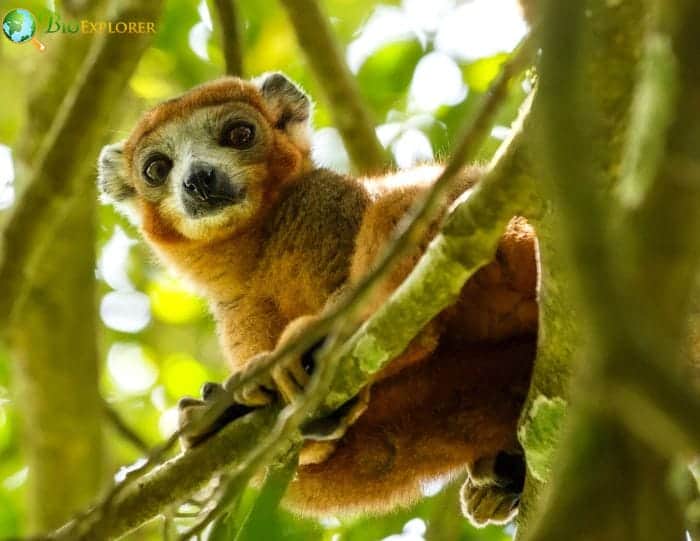
- Coloration and Markings: Blackish-gray fur covers the top and backside, with white fur on the underparts and inner limbs. Namesake triangular orange crown marking on the forehead resembles an arrowhead in shape. Distinctive white tufts of fur protrude from the ears. Gray bare skin visible on face and muzzle around dark inquisitive eyes.
- Eyes: Large, round reddish-orange eyes with keen binocular vision. Allows accurate perception of depth when moving through the rainforest canopy. Retina and optic nerves adapted for low light conditions. Color vision similar to humans with just two cone photo pigment visual pigments. .
- Teeth: Classic strepsirrhine toothcomb structure lower incisors and canines fused into a grooming implement. Used daily to comb and clean their dense fur coat. Premolars and molars adapted for grinding fibrous fruits, leaves, and seeds.
- Limbs: Long, slender arms and legs adapted for vertical clinging and leaping in trees. Powerful hind limbs can propel up to 10 meters between branches. Forelimbs assist with grasping and collecting food items.
- Hands and Feet: Toilet claw for grooming on the second digit of each foot. Pseudo-opposable thumbs allow for the basic gripping of food. Flexible feet grasp branches like a second pair of hands.
- Size Dimorphism: Males are slightly larger than females – average weight around 2 kg (4.4 lbs) for adults. Males may be up to 15% larger than their female counterparts. The blue-eyed lemur is the only other lemur species as sexually dimorphic as the crowned lemur.
Crowned Lemur Diet and Feeding Habits
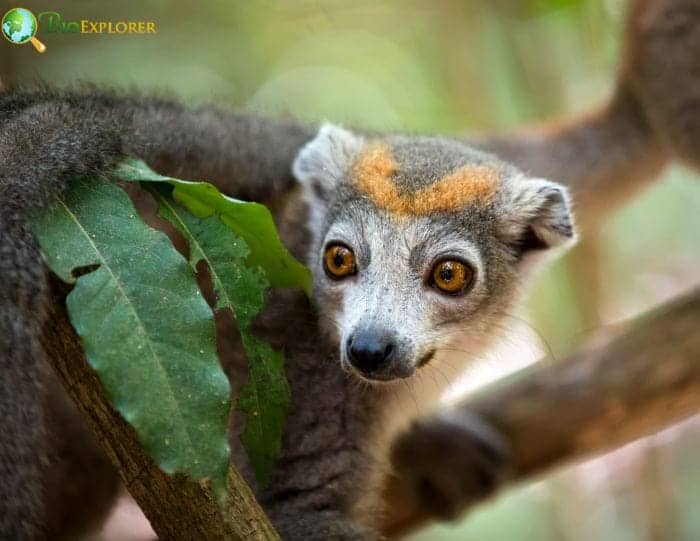
Broad vegetarian diet: Crowned lemurs have a primarily vegetarian diet, feeding on various plant matter, including fruits, leaves, seeds, flowers, herbs, fungi, tree bark, and sap. Their fruit-heavy diet assists with seed dispersal throughout their habitat. As seasonal frugivores, the crowned lemur diet shifts based on fruit availability.
Food sources: Favor figs (Ficus sp.) and tamarinds (Tamarindus indica) when available. A favorite seasonal treat is the abundant fruit and nectar from the kapok tree (Ceiba pentandra). Also, selectively forage for leaves from Mollinedia sphaerica and Brachylaena merana trees.
Foraging behavior:
- Forage quadrupedally along branches through rainforest mid-canopy.
- Use excellent sight and smell to locate ripe fruit trees and seasonal feeding sites.
- Disperse into smaller foraging groups or subgroups to cover more territory.
- Able to exploit food resources missed by other sympatric lemurs.
- Males, in particular, have been recorded descending to the ground to feed.
Insect consumption: Sharpen sight by locating stationary insects. Will occasionally supplement the usual vegetarian diet with protein-rich insects for a nutritional boost when needed. Consume more arthropods during the wet season.
Dietary selectivity: Demonstrate extreme selectivity of which fruits and leaves to ingest – reject more fibrous vegetation and plant parts. Rely heavily on ripe, pulpy fruits when abundant.
Crowned Lemur’s Digestive System
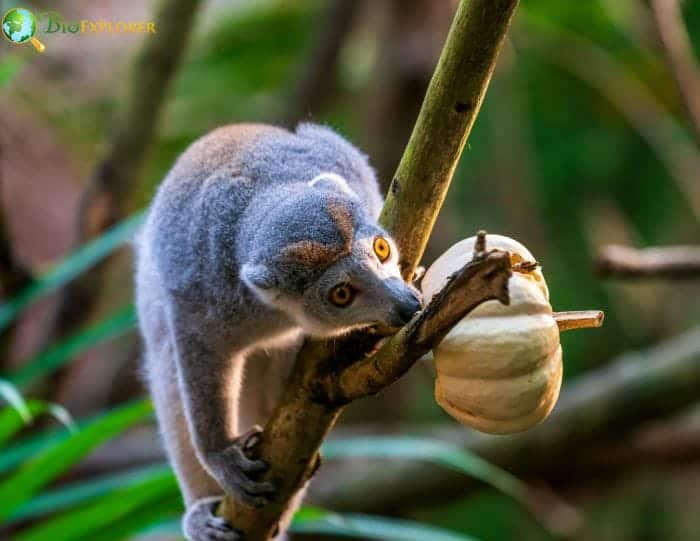
The crowned lemur has a relatively short gastrointestinal tract compared to other lemurs of similar size.
- The small intestine, cecum, and colon are all shortened lengthwise.
- This results in a low ratio of total intestine length to body size.
- No major sacculations (pouches) are present in the colon for microbial fermentation.
- However, the cecum does contain several distinctive sacculations.
Cecum Role
The cecum appears to be the crowned lemur’s main digestive chamber and fermentation site based on the presence of numerous absorptive pouches. The small intestine is responsible for most nutrient absorption, while the cecum allows the breakdown of structural plant materials.
Digestive Adaptations
Several aspects of the lemur’s rapid transit time digestive system indicate adaptation to an easily digestible diet:
- Able to process some pectins, gums, and structural polysaccharides from fruit cell walls.
- Gastrointestinal proportions geared towards food high in simple sugars, fruits, nectars.
- Less cellulose breakdown capacity compared to lemurs focused on leaves, bark.
The crowned lemur’s digestive efficiency and selectivity allow them to fulfill dietary needs from limited, high-value food resources. This is likely an evolutionary adaptation to the extreme seasonality of their habitat.
Crowned Lemur Social Structure and Behaviors

Group Living
Crowned lemurs are highly social, living in close-knit matrilineal troops of 5-15 individuals on average. This troop size is at the higher end of lemur social groupings. Each group consists of:
- Dominant breeding pair alpha male and female.
- Multiple subordinate adult males and females.
- Juveniles and infants of both sexes.
While males remain in their natal birth troop for life after maturity, females will disperse to new groups. Females form the stable core membership due to this male-biased dispersal. Complex social dynamics and hierarchies exist between and within the sexes in a troop. Females dominate the group over males, giving them advantages in food selection and mate choice.
Territoriality
Crowned troops are highly territorial, defending home range areas between 32-124 acres from neighbor groups. Border patrols and skirmishes are common activities:
- Scent marks vegetation along regular pathways with urine and glandular secretions.
- Loud, creepy, wailing vocalizations communicate territory ownership.
- Aggressive intergroup encounters when home ranges overlap with disputes and chasing.
Activity Patterns
The species exhibits cathemeral activity patterns – they are active intermittently both night and day. During daylight hours they will rest between bouts of social grooming and foraging. Midday heat will cause inactivity, while cooler temps in the morning and evening prompt peaks in feeding and moving about their range.
Crowned Lemur Scent-Marking and Communication
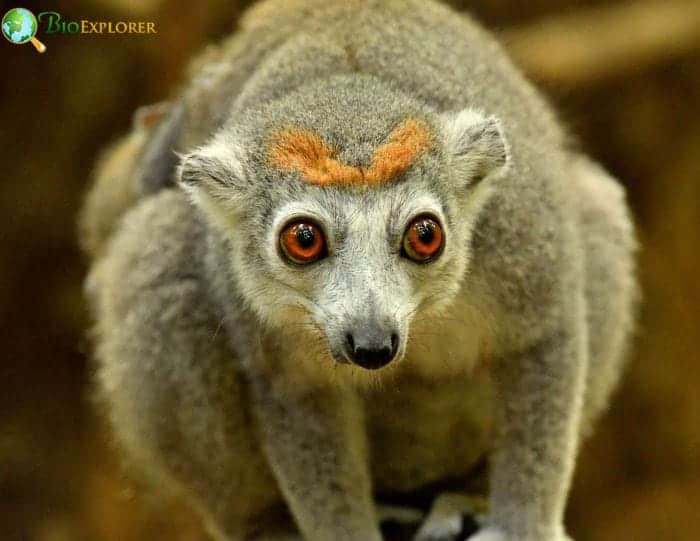
Crowned lemurs have a multimodal communication repertoire that serves vital functions from resource and mate defense to group cohesion.
Visual Displays
Face-to-face visual signals are an important communication avenue:
- Extensive variety of facial expressions involving ears, brow, and mouth to display states and intentions.
- Positioning and movements of the tail conveys social status and arousal states.
- Dominant individuals will stare, grin menacingly, and bare teeth during disputes.
Vocal Signals
Lemur groups identify each other and defend territories through acoustic signals:
- Loud, wailing territorial advertisement call audible over 1 km away through dense forest.
- Softer purrs, mews, and grunts in friendly social interactions reinforce bonds.
- High-pitched, repetitive alarm cries when predators are detected.
Scent Signaling
All age/sex classes engage in olfactory signaling of reproductive status and ownership:
- Urine washing vertical plant structures to mark territory.
- Spreading strong-smelling glandular secretions like smegma.
- Males predominantly countermark territory edges, and females mark valuable fruit trees.
The key functions of crowned lemur communication include:
- Advertising reproductive receptivity.
- Defending essential resources.
- Regulating mating access.
- Expressing dominance relations both within social groups and when encountering rival troops.
Crowned Lemur Reproduction and Breeding
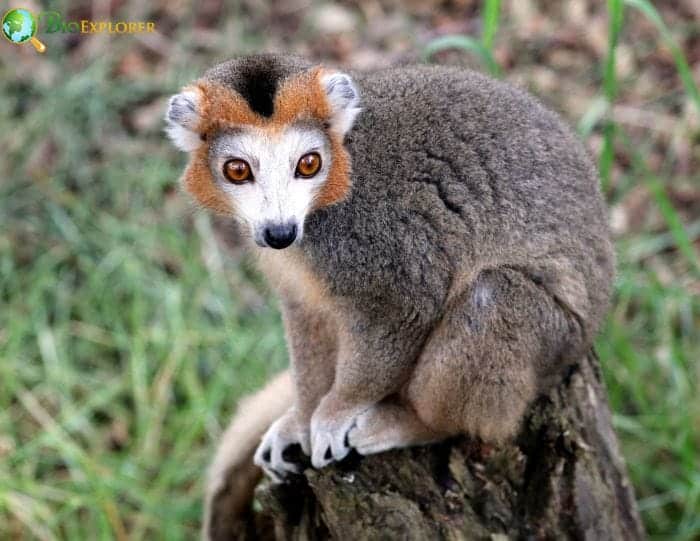
The crowned lemur breeding system reflects a mix of monogamy and polygyny. Each social group is led by a dominant breeding pair – the alpha male and alpha female. The alpha female suppresses ovulation in subordinate females via pheromones and aggression.
- Mating Season: Distinct seasonal mating behaviors correspond with the rainy season between October and March. Courtship activities intensify in early winter, influenced by shifts in day length. Males will engage in visual displays, scent marking, and fighting other males to establish access to breeding females.
- Estrous Cycling: Analysis of vaginal swabs show females cycle up to 3 times per breeding season. Cycles average 34 days in duration–the estrus period where the female is sexually receptive spans just 1 day per cycle. The reproductive state is advertised via smells and vocalizations.
- Gestation & Birth: After successful mating, gestation lasts an average of 125 days. Females usually give birth to a single infant, though twins are possible. Birthing generally occurs September-October, at the onset of the rainy season, when ample food will support lactation demands.
- Infant Development: Infants are born with fur and eyes open. They are cared for by all troop members males and non-mothers will even temporarily “kidnap” and carry the young. Weaning begins around 2 months old and finishes by 5 months. Sexual maturity is reached at 20 months by both males and females. Dispersal tends to occur before the next mating season.
Crowned Lemur’s Polyspecific Associations with Sanford’s Lemurs

Seasonal Interactions
Crowned lemurs (Eulemur coronatus) and Sanford’s brown lemurs (Eulemur fulvus sanfordi) occasionally form mixed-species foraging groups within overlapping mid-altitude rainforest habitats in northern Madagascar.
- During seasons of fruit superabundance, the species show resource tolerance and largely avoid direct interspecific interaction or competition.
- When resources become scarcer in the dry season, the species actively seek each other out to form polyspecific associations that may last several months.
Foraging Benefits
Several potential benefits help explain the formation of seasonal mixed troops between these sister taxa:
- Enhanced foraging efficiency by covering more forest area as a larger group.
- Take advantage of missed resources in the canopy and minimal niche overlap.
- Improved predator detection from increased eyes and ears on alert.
- May locate seasonal resources like tree fruit blooms more rapidly.
Spatial Dynamics
When associating with mixed foraging parties, the troops display high spatial cohesion:
- Coordinate activities moving together through shared home range boundaries.
- Rest nearby between bouts of intensive seasonal foraging.
- Interindividual distances contract compared to single-species groups.
- Increased social grooming and play observed between juveniles.
Crowned Lemur Conservation Status and Threats
The crowned lemur is currently classified as Endangered on the IUCN Red List due to habitat loss, hunting, and their limited range:
- Listed as one of “The World’s 25 Most Endangered Primates” 2002-2014.
- There is a high risk of extinction in the wild if conservation action is not taken.
- The current population estimated to be between 1,000 and 10,000 mature individuals.
Crowned lemurs are said to have lived up to 36 years in captivity, but an average of 27 years in the wild.
Habitat Loss
Rapid deforestation for timber, mining, and agriculture represents the gravest threat:
- Northern Madagascar forests critically endangered from slash-and-burn clearing.
- Ankarana Reserve faces threats from illegal logging and charcoal production.
- Fragmentation isolates tiny lemur populations with limited genetic diversity.
Hunting Pressures
Bushmeat hunting of all wildlife, including lemurs, is increasing to meet food demand. The lack of local taboos compounds the problem.
What Eats Crowned Lemurs?
Due to their small size, crowned lemurs face threats from various predators within their forest habitat. Key natural predators include:
Raptors:
- Madagascar buzzards target juveniles and small adults.
- Harrier hawks regularly prey on lemurs for food.
Carnivorans:
- The fossa main mammalian predator, threats all age classes.
Avoidance Strategies:
To minimize falling victim to predators, crowned lemurs utilize:
- Group mobbing and aggression to drive threats away.
- Cryptic freeze camouflage in foliage when stalked.
- Early warning cries to alert groupmates.
- Hide infants in dense thickets and nests high in trees.
Crowned Lemur Captive Breeding
Targeted captive breeding efforts seek to safeguard vulnerable crowned lemur populations while also facilitating research:
Captive Lifespans
On average, Crowned lemurs are said to have lived up to 36 years in captivity, but an average of 27 years in the wild.
Breeding Success Factors
Analysis of reproductive success factors across captive crowned lemur populations shows:
- Groups with multiple males and females have much higher breeding rates.
- Permitting familiar groups to remain together improves infant survival odds.
- Mimicking seasonal fruit cycles seen in the wild forest environment.
Research Value
Meticulous biological data continues being gathered on captive groups to determine the following:
- Details of female reproductive cycling via vaginal swab analysis.
- An average gestation period of 125 days.
- Developmental milestones from infancy through to maturity.
Targeted ex-situ conservation helps provide an insurance population to support this high-risk endangered species.
Crowned Lemur Fun Facts
- Nest Innovators: Of all lemur species, the crowned lemur uniquely constructs arboreal sleeping nests out of interwoven twigs, branches, and leafy vegetation rather than using tree cavities or dense thickets. This architectural innovation likely helps conceal lemur groups from aerial and arboreal predators at night.
- Vocal Advertisers: The crowned lemur’s loud, wailing “honk-bark” territorial advertisement call can be heard over 1 km away by rival troops. The haunting, howler-monkey-esque vocalization helps reinforce spatial boundaries between neighboring groups in thick northern forests.
- Excuse Me!: A study examining parasites in wild crowned lemurs found about one-third hosted potentially unpleasant Strongyloides gut worms. However, the nematode parasites did not seem to cause sickness despite infesting the digestive tract. Better out than in!
- Conservation Pioneers: The San Diego Zoo has spearheaded crowned lemur captive breeding since 1982 their early ex-situ conservation efforts help protect this high-risk species.
- Picky Eaters: Wild crowned lemurs reject significantly more mature fruits, seeds, and fibrous vegetation than sympatric Sanford’s brown lemurs in the same habitat. Their extreme selectivity means fewer calories overall, indicating a more precise, nutrient-focused dietary strategy.
- Once Were More: Paleontological and archaeological evidence suggests up to 14 different extinct and living lemur species once overlapped in the same northern Madagascar forests where only the crowned lemur persists today.
- Fruit Flyers: To efficiently traverse the tight spaces between crowns of tall rainforest canopy trees, crowned lemurs utilize extremely powerful hindlimbs that propel them, leaping a horizontal distance of over 10 meters not bad for a little lemur!
- Smelly Signallers: Crowned lemurs possess various scent glands throughout their bodies that, combined with urine washing of tails, yield diverse body odor “signatures” communicating social status and reproductive state between individuals.
- Agile Acrobats: Excellent depth and distance perception stemming from their large front-facing, binocular vision assists crowned lemurs in the superb balance, vertical clinging, leaping, and aerial maneuvers necessary for smooth locomotion through the complex forest canopy zone.
- Rainy Playtimes: In the wild, the crowned lemur’s mating and birthing seasons strategically correspond with rainy October-March cycles. This reproductive timing ensures nursing mothers and growing infants will have plenty of blossoming flowers, ripe fruits, and flowing nectar to fill tiny lemur tummies!
Frequently Asked Questions

What is the habitat of the eulemur coronatus?
The Eulemur Coronatus, also known as Crowned Lemur, is predominantly found in the deciduous forests at the northern tip of Madagascar, an island off the southeast coast of Africa. They can also be observed in the Montagne d’Ambre and Ankarana reserves in Madagascar.
Can we see eulemur coronatus in a zoo?
Yes, Crowned Lemurs can be seen in various zoos worldwide. They are often included in conservation programs due to their status on the Red List of Threatened Species.
What is the mating behavior of Crowned Lemurs?
Could you describe the distribution and habitat of Crowned Lemurs?
Crowned Lemurs are primarily distributed along the northern tip of Madagascar. They inhabit deciduous forests and the levels of the forest where they forage for food and rest. They are especially active during the day.
Crowned Lemurs are quite sociable and live in groups that often have a female as the leader. Like other lemurs, the crowned lemurs also display certain social behaviors such as grooming each other using their incisors and canine teeth.
How does the crowned lemur look like?
The Eulemur Coronatus lemur species are sexually dichromatic – males and females look different. Males have a gray body with an orange crown and black face, while females are reddish-brown with a black and orange crown. Both have a long tail, indicative of the species.
What does the Crowned Lemur mainly feed on?
The Crowned Lemurs primarily feed on fruits, flowers, and leaves. They also use their long, narrow snouts to feed on nectar and pollen from flowers.
When are young Crowned Lemurs usually born?
The young are usually born around September and October, following a mating season that typically occurs between May and June.
When are Crowned Lemurs most active?
Like all lemurs, Crowned lemurs are diurnal and active during the day, especially in the early morning and late afternoon.
Are Crowned Lemurs endangered?
Yes, Crowned Lemurs are listed as endangered on the Red List of Threatened Species due to habitat loss from agriculture, livestock farming, and urbanization. They can be found in four reserves on the northern tip of the island of Madagascar, where conservation efforts are ongoing.
Conclusion
The magnificent crowned lemur has adapted to thrive in the seasonal rainforest canopies of northern Madagascar despite being classified as Endangered. With a very restricted and threatened range, habitat loss poses a constant danger even within nominally protected reserves. Spearheaded by conservation pioneers like the San Diego Zoo, targeted captive breeding efforts seek to safeguard populations of this stunning primate.
With unique physical features like dense water-resistant fur and a built-in grooming comb, the crowned lemur survives in a delicate treetop environment that would challenge most other mammals. From specialized scent-marking communications and selective feeding strategies to surprising feats of leaps and acrobatics through the canopy, the crowned lemur demonstrates what makes lemurs such a distinctive evolutionary radiation worthy of global focus to save from extinction.
While severe challenges remain, recent expansions of environmental education efforts targeting local communities offer some bright spots in ensuring the enduring survival of Eulemur coronatus in its island home. We can conserve their forests and the incredible biodiversity these prosimian primates represent only through ongoing protection of Madagascar’s precious lemurs like the crowned lemur.











